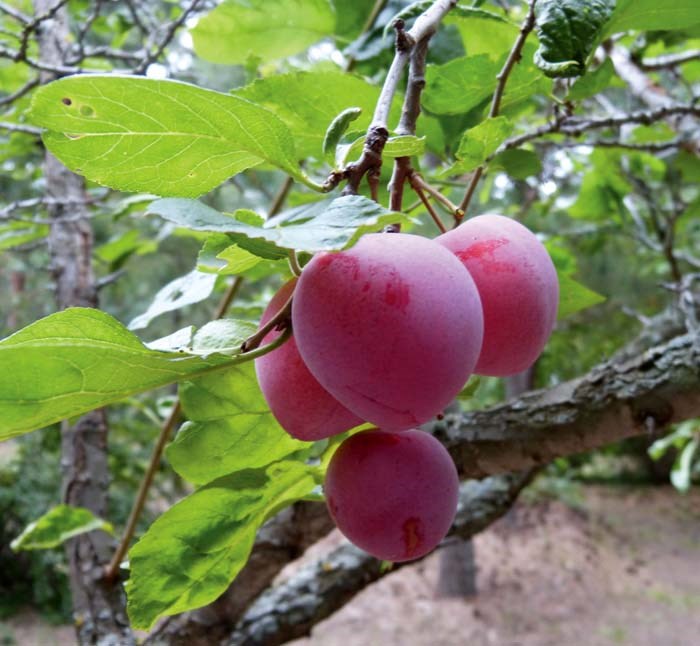Two of my favourite plums for fresh eating, crisps and plum cake are ‘Patterson Pride’ and ‘Pembina’.
‘Patterson Pride’ was one of Dr. Cecil Patterson’s selections from 1942 but not introduced until 1960 (Dr. Patterson was the first head of the University of Saskatchewan’s Horticulture Science Department). Its fruit is sweet, tender and juicy with bright red skin and golden flesh. The 4.5 cm diameter free-stone plums ripen from mid-August onwards. The tree is semi-dwarf with slightly weeping branches.
‘Pembina’ matures a week or so later. Its fruit is 5 cm in diameter with orange-gold, soft, juicy and sweet flesh wrapped in dark red skin with a heavy bluish bloom, almost purple. The tree is more upright, spreading and vase-shaped.
Planted about 30 years ago on a sandy knoll, they have been amazingly drought-tolerant and are still producing well.
One of the perceived problems with growing plums is pollination. Without successful pollination there is no fruit. So, what makes a good pollinator? As Darryl Fehr of the Little Tree Nursery, Martinsville, puts it, “Nobody knows what the plums are doing at night.” But it is not as complicated or confusing as once thought. There are 4 major groups of prairie-hardy plums: (a) hybrids of the Asian and Canada wild plums (b) Canada plum selections (c) Asian plum selections, and (d) cherry plums.
‘Patterson Pride’ and ‘Pembina’ are in the first group, hybrids of our native Canada wild plum (Prunus nigra) and the Asian plum (P. salicina). Others in this group are ‘Prairie’, ‘Supreme’, ‘Superb’ (syn. ‘Perfection’), ‘Geddes’ and ‘Brookred’. These hybrids will not pollinate each other or any other plum. In order to produce fruit, these hybrids must be planted close enough to a Canada wild plum for a bee to transfer pollen. Although less available in the nursery trade than they once were, several prairie nurseries continue to offer Canada wild plums. Their fruit is small but they make an excellent ornamental as well as serving in the role of pollinator.
Canada plum (P. nigra) selections are the second group of plums in terms of pollination. ‘Dandy’, in this group, is best pollinated by a Canada wild plum. Its clingstone fruit is 3-4 cm in diameter with yellow, mild and juicy flesh. The skin is yellow blushed with red, thin, tender but astringent and slightly bitter. Only fair for fresh eating, it is excellent for jam. It is also an excellent pollinator for other early flowering plums such as ‘Brookgold’.
The Asian plum cultivars will pollinate each other. You will need two different cultivars within bee-flying distance. Among these are:
• ‘Brookgold’ – 2.5-3 cm; bright gold skin with orange blush; juicy, very sweet yellow flesh; free-stone; great for fresh eating; poor for canning and jam.
• ‘Fofonoff’ (syn. ‘Homesteader’) – 4 cm; flesh is light green, firm, juicy, very sweet; free-stone; light green skin with pink bloom, thin and tender; good for fresh eating and jam.
• ‘Ivanoka’ – 3.5-4 cm; flesh is orange-pink, firm, juicy, sweet; semi-free-stone; skin is yellow with red over-lay; good for jam and pies
The last group is the cherry plums, hybrids between the western sandcherry (P. besseyi) and the Asian plum. Among these are ‘Dura’, ‘Manor’, ‘Opata’ and ‘Green Elf’. Their fruit is about 3 cm in diameter and very flavourful. Cherry plum cultivars will pollinate each other; sandcherries will also pollinate the cherry plums. However, contrary to popular belief, sandcherries will not pollinate plums.
Sara is the author of numerous gardening books, among them the revised Creating the Prairie Xeriscape; and with Hugh Skinner: Gardening Naturally; Trees and Shrubs for the Prairies, and Groundcovers & Vines for the Prairies.
This column is provided courtesy of the Saskatchewan Perennial Society (www.saskperennial.ca; [email protected]; www.facebook.com/saskperennial). Check out our Bulletin Board or Calendar for upcoming garden information sessions, workshops, tours and other events: Sept 18, 1 – 4pm: A touch of Autumn at the Honeywood Heritage Nursery, Parkside Saskatchewan; an opportunity to marvel at the fall colours and delight in their apple and rhubarb pies. (http://www.honeywood-lilies.ca/)




